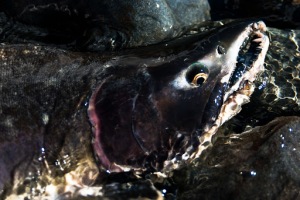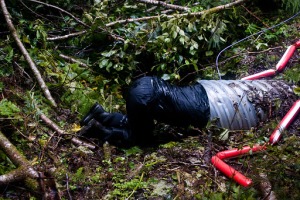The first thing to do after a blast is to make sure you still have all your fingers!
Visiting Canadian blaster counts his fingers.
Or maybe he’s just doing a conversion from metric?
Just kidding! The first thing to do after a blast is to wait a minute for everything that went up in the sky to come back down to earth. Then the Blaster In Charge goes up to the blasting site to do a safety check, looking for unexploded explosives, large rocks and/or logs precariously balanced in trees, deaf bears traveling at high speeds, that sort of thing. The rest of the crew follows when the ‘all clear’ is given over the radio.
Foreground: Blaster. Background: Cautious approach by crew.
Returning to the first blasting sites was definitely a bit shocking. We’re in a (coastal temperate) rainforest, everything is lush and green and there are trees and the whole roadbed is overgrown to the point that if you wanted to bring any sort of heavy equipment in you’d have to rebuild the whole thing, and then…
Oh! Hi, muddy brown trench that we just created.
The parting of the road bed
From green to brown in 60 seconds or less. Actually, it’s probably more like 60 milliseconds or less. And that’s a good thing — one split-second boom, a few seconds of thunder rolling in the hills, and the work is done. It’s quick, it’s cheap, and it’s green.
The alternative to explosives is, actually, to rebuild the road so that excavators (you know, the sort of yellow digging machines that little kids like to play with in the sandbox) can get up the end of the road and then start back, digging out the culverts as it goes. That would take a barge to bring in the equipment, fuel and oil to keep it running. Blasting brings the explosives in by helicopter, drops them where they’re needed, and the crew walks in and sets them off. After the blast, the explosives, and anything right next to them, have vaporized and disperses into the atmosphere. There’s no residue of any sort left in the forest – compare that to the inevitable grease trail left by heavy machinery.
Watershed coordinator contemplating stream bed.
After the blast, the main remnant was hunks of culvert. However, since they’ve been exposed to the explosives, the galvanization which was keeping them intact is gone. The crew made sure to remove the leftover culvert bits from the stream bed, but left them in the forest to rust away.
Removing the end of a culvert from the steam.
While more explosives would probably vaporize all of the culvert, the blaster in charge of the project, Rob Miller (also the Master Blaster for all the Forest Service’s operations in Alaska) has spent a fair of time and calculation to work out what is the minimum amount of explosive needed to get the job done. Many of the culverts are removed with $100-$200 worth of explosives – pretty cheap! More explosives could make a bigger hole, sure, but a big hole isn’t the point – the point is to make sure that instead of a narrow passageway under a road that could get plugged with rocks and dirt or possibly cave in, there is instead a free flowing stream bed that will be able to flow naturally and do its part for ecosystem function, and support the bigger streams downhill where there are salmon.
 |
| Run free, little stream, run free! |
In the pouring rain, the mud washed away quickly, and the water turned clear. In another month, part of the crew will return to the sites to see how they’re doing. Next summer they’ll be back to take out the second half of the road. It’s probably a long shot, but I hope I’ll be able to go, too!






















